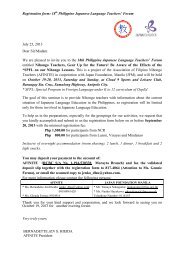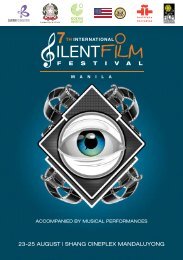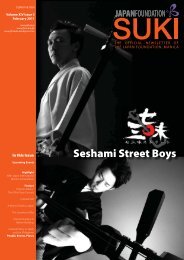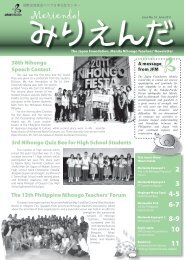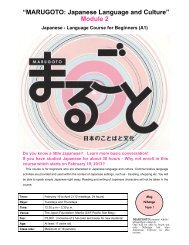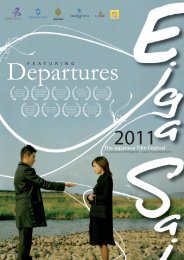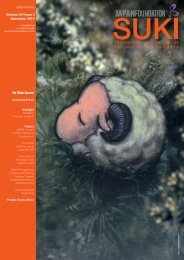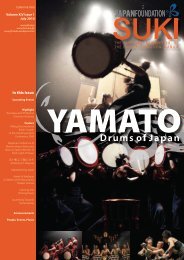In this Issue - The Japan Foundation, Manila
In this Issue - The Japan Foundation, Manila
In this Issue - The Japan Foundation, Manila
- No tags were found...
You also want an ePaper? Increase the reach of your titles
YUMPU automatically turns print PDFs into web optimized ePapers that Google loves.
Upcoming EventsEditorial StaffKOTO: <strong>Japan</strong>ese Traditional Musicby Chieko FukudaWorkshops/ Lecture-RecitalUP College of MusicFebruary 25 – March 2, 2009Embassy NightPhilippine <strong>In</strong>ternational Jazz FestivalRockwell TentFebruary 26; 6:00 pm (By <strong>In</strong>vitation Only)<strong>The</strong> <strong>Japan</strong> <strong>Foundation</strong>, <strong>Manila</strong> (JFM) andthe UP College of Music, Department ofEthnomusicology present “Koto: <strong>Japan</strong>eseTraditional Music”, a workshop series andlecture-performance conducted by <strong>Japan</strong>esetraditional musician, Ms. Chieko Fukuda fromFebruary 25 – March 2, at the UP College ofMusic.Ben SuzukiEditor-in-ChiefYukie MitomiAssociate EditorCecilia EJ AquinoBambi DiazKathy V. PiqueRoland SamsonStaffISSN 0118-7910Volume XII <strong>Issue</strong> 3February 2009<strong>Japan</strong>ese Edo KiteSuki is a newsletter published by <strong>The</strong> <strong>Japan</strong> <strong>Foundation</strong>,<strong>Manila</strong> (JFM) located at the 12th Floor, Pacific StarBuilding, Sen. Gil Puyat Avenue, cor. Makati Avenue,Makati City 1226, with telephone numbers (632) 811-6155to 58, fax number (632) 811-6153; and email address atemail@jfmo.org.ph.Suki is published three times a year and is duly registeredas printed matter mail at the Makati Central Post Officeunder Permit No. 1074-97 NCR dated June 16, 1997. It isdistributed free of charge to individuals and organizationsinterested in <strong>Japan</strong>ese Studies and <strong>In</strong>ternational CultureExchange.<strong>The</strong> opinions expressed in the feature articles are ofthe authors and not necessarily of the <strong>Foundation</strong>.Reproduction in whole or part of Suki articles isprohibited without permission from the author and <strong>The</strong><strong>Japan</strong> <strong>Foundation</strong>, <strong>Manila</strong>.<strong>The</strong> workshop starts February 25, incorporatingindividual koto coaching sessions with Ms.Fukuda, until March 2.A lecture-performance by Ms. Fukuda, withthe participation of select Filipino participants,will be staged on February 27, Friday, 6:00 pmat the Abelardo Hall, UP College of Music,Diliman, Quezon City.<strong>In</strong> her capacity as Special Advisor forCultural Exchange by <strong>Japan</strong>’s Agency forCultural Affairs, she performs with renownedinternational jazz musicians at the “EmbassyNight” of the Philippine <strong>In</strong>ternational JazzFestival on February 26, Thursday, 6:00 pm atthe Rockwell Tent.For details contact:981-8500 loc. 2635 or 925-7139for UP Workshop/ Lecture-Recitalwww.pijazzfest.com for Embassy NightPhilippine <strong>In</strong>ternational Jazz FestivalAnnual Graduate Students’ ConferenceNation-States and Global Crises:Asian <strong>Issue</strong>s and PerspectivesFebruary 27-28, 2009Bulwagang Sala’am, Romulo Hall, UP DilimanRecognizing the relevance of the presentglobal crisis, the conference aims to gatherdifferent multi-disciplinary perspectives onthe dynamics that are shaping the relationshipbetween nation-states and global forces.For details contact tel. no. 927-0909University of the Philippines – Asian CenterNihongo Fiesta 2009February 28 & March 1SM Mall of Asia<strong>The</strong> <strong>Japan</strong> <strong>Foundation</strong>, <strong>Manila</strong> and the SM Mallof Asia present a weekend festival of Filipino-<strong>Japan</strong>ese fun and learning activities such asthe 11th Asian Cartoon Exhibition, the 2ndPhilippine-<strong>Japan</strong> Kite Exhibit/Demonstration,Koto: <strong>Japan</strong>ese Traditional Music Performedby Ms. Chieko Fukuda, and the 36th NihongoSpeech Contest which includes the 1st JFMQuiz Bee.<strong>The</strong> 11th Asian Cartoon Exhibition willshowcase the comic illustrations of 10 Asiancartoonists on the theme “Asian Youth Culture”.<strong>The</strong> Philippines is represented by Beerkadacreator/cartoonist,Lyndon Gregorio. A specialdisplay will also be launched for the Bronzewinner of the 2nd <strong>In</strong>ternational MangaCompetition, Mr. Kriss Sison. <strong>The</strong> works will beon display until March 15.EDO (old Tokyo) kitesthrough workshops.<strong>The</strong>re will also bekite making/flyingcompetition foreveryone.Listen to the timehonoredsounds of<strong>Japan</strong> as Ms. ChiekoFukuda, renowned<strong>Japan</strong>ese traditionalmusician, performson the Koto, a<strong>Japan</strong>ese traditionalstringed instrument.Filipino finalistscoming fromvarious regions ofthe country willconverge for the 36th Nihongo SpeechContest to demonstrate their linguistic skillsby delivering an original composition writtenby themselves on a theme of their choice.Winners of the speech contest will take partin an all-expense-paid week-long studytour in <strong>Japan</strong>. <strong>The</strong> 1st JFM Quiz Bee will beparticipated in by various Metro <strong>Manila</strong> highschools under the JF/JENESYS Program.All activities are open to the public for FREE!Please see back cover for the schedule andvenues.<strong>In</strong>ternational Conference:“<strong>The</strong> Philippines and <strong>Japan</strong> in East Asia andthe World: Identity, Image and Roles”March 19-20, 2009<strong>The</strong> conference examines the major foreignpolicy thrusts, objectives and concerns of thePhilippines and <strong>Japan</strong> in the post WW2 era upto the present, and analyzes to what extentthe contemporary foreign policies of thesetwo countries converge, diverge, or intersect,set against the east Asian and global contexts.It covers different dimensions: externalsecurity, foreign economic relations, regionalpolicy, labor migration, the role of civil society,and issues of identity and institutions.For details contact tel. no. 927-0909University of the Philippines – Asian CenterEco-Products <strong>In</strong>ternational Fair 2009Sustainable Production, SustainableConsumption, Sustainable FutureMarch 19-22, 2009SMX Convention Center, <strong>Manila</strong>Largest international environmental fair and<strong>The</strong> 2nd Philippine-<strong>Japan</strong>ese Kite Exhibit/Demonstration will bring the art and sportof kite flying to a higher level. Be fascinatedwith the kite exhibition from both Filipino and<strong>Japan</strong>ese kite flyers. Mr. Mikio Toki, a resourceperson from <strong>Japan</strong> will share his expertise on
HIGHLIGHT>> FROM PAGE 3regardless of race, gender, or age. Whilematerial deprivation is most obvious in allcases what stays are images of isolation,despair and humiliation. When povertystrikes it robs people of their dignity andhonor as human beings. No one was bornonly to become homeless or hungry.Poverty is the antithesis to the honor ofhuman life. But to see these images in <strong>Japan</strong>was truly something else. Our reactions todiscovering homeless or hungry peoplein <strong>Japan</strong> ranged from surprise to disbelief,from pity to compassion, from confusionto compulsion to act. Our journey into <strong>this</strong>strange world was made comprehensibleby the invaluable companionship of thosewho have gone ahead of us, the NPO’s andtheir dedicated leaders. <strong>The</strong>y acceptedsuch reality when very few of their ownpeople were even aware, they took on thechallenge of responding to their needswhile most of <strong>Japan</strong> cared too little to evenknow more about it.But our initiation into the world of thepoor was brought to its greatest heightwhen we were made to understand itsmachinery. It all starts with joblessness andfrom there a chain reaction is triggered thatcause people to fall into the cracks of anotherwise effective <strong>Japan</strong>ese social securitysystem. <strong>In</strong> discussing the plight of the poor,our lecturers inevitably revealed to us theunique workings and intimate connectionsof employment and life in <strong>Japan</strong>. Equallyshocking to the reality of poverty was theprinciple of life-long employment. Andnow that <strong>this</strong> system is being shaken by therealities of modern economics and currentrecession it is wreaking havoc in the livesof those who lose their jobs, specially theolder men. Being jobless is the first stepto a series of misfortunes that being bybeing on welfare to being homeless tobeing hungry. And somewhere along theway the poor in <strong>Japan</strong> becomes isolated.<strong>The</strong> lack of alternative support systems(family, friends, NPO’s) was a start void thatmost of us took notice of. Why were theseabsent? This question then led us to therealities that compounded the situation:declining family ties, job-centered lives,meritocracy and materialism, a civil societythat was never needed, a governmentthat provided everything to the point ofcreating dependency and dampening civilempowerment.This aspect of our trip was bothsaddening but also hopeful. We tried toJENESYS participants discussing with <strong>Japan</strong>ese people regarding their welfare in Kotobuki-cho, Yokohama.see beyond the details and read betweenthe lines. Our alarm and concern for therising incidence of poverty was met withthe dynamism of ideas and prospectsfor change. We drew hope from the fewwho dared to rise up to the challenge.Our forays into the unpopular realmsof <strong>Japan</strong> brought with it the privilegeof meeting the remarkable men andwomen at the frontiers the battle againstpoverty in <strong>Japan</strong>. It is their passion anddedication that triggered our ideas andhopes. So long as they are there thepoor in <strong>Japan</strong> will never be truly alone.Our brief encounters were simply notenough to forge plans but was definitelyenough to lay the foundations for futurecollaboration. It is our hope that ourencounters provided our <strong>Japan</strong>ese NPOcounterparts with hope, inspiration, andperspective that they are not alone in thebattle that they are fighting, that theyhave a companions in the 16 countrieswho were present. <strong>The</strong> key to survivingthese rough times is to stay together andto not leave anyone behind. That in thesetrying times, it is not just governmentwho is to be trusted (or blamed?) for asolution but that every <strong>Japan</strong>ese citizenis involved and can make a difference ifgiven the inspiration, chance, and supportto make it happen. Somehow, in betweenthe cracks of <strong>this</strong> faltering economicsystem there is a resounding desire towork together, to be in community, asin the spirit of the mura, as the first steptowards a better <strong>Japan</strong>.Finally, the trip gave us somethingbeyond <strong>Japan</strong>. It gave us the gift offriendship from 16 countries. While mostof the trip was spent on knowing <strong>Japan</strong>,in between the tightly knit schedule wealso had the opportunity to glimpse intothe world of other countries. <strong>In</strong> <strong>this</strong> trip,I began seeing beyond my own country.Almost comically, a sinking ship in <strong>Manila</strong>now matters to my friend from Australiasimply because I might be on that boat!Or if Thailand elects a new PM, it nowmatters to me because it may spell thedifference between being able to land ornot land in Bangkok. Simply put, foreignaffairs have become personal concernsfor each of the 20 participants. <strong>Japan</strong> isfamous in my country for building a lotof bridges and roads. And I think it didthe same thing for me during <strong>this</strong> trip.<strong>The</strong> JENESYS program put me on anexpressway into understanding <strong>Japan</strong>and its challenges on poverty but it alsoopened up side roads and detours intothe world my Asian neighbors. And it wasa great privilege to meet the best fromthese countries, the future leaders of Asia.And no matter how small and partiallysignificant we are right now we hope thatwe live up to our destiny of being futureleaders and really make the difference thathas long been spoken. And forging theseconnections could not have come at abetter time. It is very important to rekindle<strong>this</strong> connection in a setting of an impedingonce-in-a-century global economic crisis.This crisis was triggered by a sophisticatedform of greed and propelled by fear. Andpeople the world over are just so afraidand insecure. But as we build bridges androads of understanding and friendship wesomehow feel less afraid because of theassurance that we are not alone. Somehowin doing what each of us are doing forour own countries we feel that we canask our friends in Asia and Oceania forsupport and encouragement. Becauseof <strong>this</strong> trip we are beginning to see <strong>this</strong>corner of <strong>this</strong> world as our neighborhood,our community, and in so many waysmaybe one big little Asia-mura.*Mura means a village in <strong>Japan</strong>ese language.Mark Lawrence Cruz is a coordinator of Gawad Kalinga-Ateneo Coordinating Office; and participant for JENESYS Program on “Overcoming Poverty through a Social inclusion Approach:<strong>The</strong> Status Quo of Asia and Oceania in a Globalized Economy” (December 9-19, 2008).
Mass Appeal:ANIMATIONSome Thoughts on the Mainstreamingof Anime in the Philippines by Rochelle DumlaoTwelve not-so-long years ago,the after-school routines of an entiregeneration of Filipino children involvedgetting home, playing in the streetsfor an hour or so, and then settling infront of the television to watch cartoonsbefore the evening news came on. Unlikethe educational slant of early morningcartoons, the evening shows featuredmore intense action, more uproariousslapstick, and more involved storylinesthan their Disney ilk.We are, of course, talking about<strong>Japan</strong>ese animated shows. Dubbed inFilipino or English and ranging in titlesfrom Dragonball Z to YuYu Hakusho(known locally as Ghost Fighters), <strong>Japan</strong>eseanime became as familiar to Filipino kidsas sweet-style spaghetti and corn andcheese ice cream.With the advent of cable TV and highspeed<strong>In</strong>ternet, Filipino kids these days– along with their enthusiastic parentsand even their nostalgic grandparents,are exposed to even more anime thanever before. Not only are the shows readilyaccessible and more varied, there are alsofurther opportunities to become deeplyinvolved in the hobby.Local specialty stores and departmentstores carry DVDs, action figures andtoys, and other collectible merchandise.<strong>In</strong>dependent comic retailers and largebook chains carry <strong>Japan</strong>ese comic booksand magazines, both in English or in theirnative Nihongo. <strong>The</strong>re are also importshops and online sellers that ship inanimation-related items direct from<strong>Japan</strong>, like special edition boxed setsand resin animation figures. <strong>The</strong> rangeof merchandise available on the localmarket today would be bewildering in thestandards of the previous generation.<strong>The</strong> down side to all <strong>this</strong> open accessis that some of the newer fans – especiallythose who were introduced to the hobbyfairly recently via the <strong>In</strong>ternet – havegrown a sort of entitlement complex withregards to anime and manga. <strong>In</strong>stead ofpainstakingly waiting for and purchasingthe official releases, they would rathergo to online file-sharing services anddownload the material. If the files are stillin their native <strong>Japan</strong>ese (which are usuallythe case with newer titles), these fanscomplain that the translations aren’t beingdone as quickly as possible, or worse,that the original authors or animators areworking too slowly for their tastes.For the record, sharing files is notinherently wrong, and it is one of thethings that make the <strong>In</strong>ternet such awonderful tool; however, if these fans startthinking that having downloaded material– without purchasing at least some of themerchandise attached to the franchise,gives them the right to act like spoiledbrats, then there is definitely a problem.<strong>In</strong>stead of playing the blame gameand pitting fans against each other,perhaps a better idea would be toencourage these fans to stop sittingaround waiting for translations, and goout and learn proper <strong>Japan</strong>ese. It’s as gooda reason as any to learn a new language– and who knows, it could be the start ofa long, dedicated desire to learn about<strong>Japan</strong> in all its complexity.I personally admit to <strong>this</strong>, havingstarted out learning the language tosupport a burgeoning addiction to anime,but ultimately it led to several scholarshipgrants to <strong>Japan</strong> and earning a Level 2Certificate in the JLPT. Other fans in thelocal community have also turned <strong>this</strong>passion into an advantage: some areputting up businesses catering to fellowfans, while others are using the animecommunity to further their academicgoals in the fields of social research andcultural study. Some have even gone onto work for <strong>Japan</strong>ese corporations andagencies, utilizing their <strong>Japan</strong>ese skillsrooted in their initial interest in anime.<strong>The</strong>re really is no limit to the good onecan do if given the proper motivationand guidance.<strong>The</strong>re are always two sides to any fador boom, and the rise of the anime fanculture in the Philippines is no different.<strong>The</strong> best we can do is to harness <strong>this</strong>passion into something positive – touse it as a tool to teach and to learn, toencourage and innovate. <strong>The</strong>se aren’t justcartoons anymore – it’s an introductionto an entirely new culture and a differentway of life.Rochelle Dumlao is a former JASSO and JAL Scholarfrom UP Diliman. She is also one of the administrators forONGAKU SOCIETY (http://ongaku-society.org), the largest<strong>Japan</strong>ese music community in the Philippines. Rochellelikes to travel abroad to attend music events and animeconventions to see how different (or similar!) they are tolocal events.By Lyndon GregorioLYNDON GREGORIOLyndon Gregorio is the pseudonym of Le Roy Lagdameo, creator of the comic strip, BEERKADA, published daily in the Philippine Star. He has since self-published eight BEERKADA comicbooks, with a ninth installation coming out in February 2009. Lyndon is a graduate of UP Diliman, and is now working full-time developing Beerkada and his other works.Lyndon Gregorio is the Philippine representative to the 11th Asian Cartoon Exhibit.
ANIMATIONDiscoveringTakuFurukawaby Avic IlaganMine is an anomalous case of being someone who worksfor an animation group but who is not totally literate in animation.I did produce animation works for children way back in my dayswith PETA Broadcast & Film. I have seen alternative/independentanimation films at Mowelfund Film <strong>In</strong>stitute, basically, worksby Canadian, French, Russian, Czech and British experimentalanimators. Clay animation, sand animation, paint on glass, stopmotion, paper, line drawing, are some of the forms and styles Ihave been exposed to and admired. I appreciated the works, butdid not know the creators.When <strong>Japan</strong>ese anime lorded over TV sets in Philippineshores, I was never a fan. I never even watched. I must admitI did not know a thing about <strong>Japan</strong>ese anime. This was why,when I once handled an anime event during my days as EventsCoordinator, the rock-star popularity of the anime artist whocame for that event was such an eye-opening surprise for me(aside from the irony that I even accepted the job). <strong>The</strong> Filipinoyouth, who jam packed the Megatrade hall, treated the <strong>Japan</strong>eseartist like a hero.My curiosity about <strong>Japan</strong>ese animation was further stirredwhen, during an animation forum, Ronnie del Carmen of Pixarshared with us a clip from Isao Takahata’s “My Neighbors, theYamadas”. Ronnie showed a sequence where the salaried man iscaught by a downpour while on his way home. Taking shelter ina grocery store, he phones home to ask any of his family to fetchhim or bring him an umbrella. Neither his wife nor his two kidsseem to want to go, pointing to each other. His wife asks him tobuy some stuff from the grocery, however. Sad and disappointed,the salaried man still follows his wife’s request. On his way out,he finds his family, wife and two kids, all waiting for him with anextra umbrella. <strong>The</strong>y go home together in silence, yet there is asense of deep family connection. <strong>The</strong> animation was done withsimple childlike drawings and in black and white. <strong>The</strong> story wasof a simple family situation, yet was deeply endearing to theaudience’s heart. That clip made me want more, made me realizethat <strong>Japan</strong>ese animation was not all Voltes V and Dragonball Z.And that it was probably about time I started to watch more<strong>Japan</strong>ese animation.So when I was negotiating with <strong>The</strong> <strong>Japan</strong> <strong>Foundation</strong> fora master class by a <strong>Japan</strong>ese animation expert to be held as partof the Animahenasyon 2008 2nd Pinoy Animation Festival, I hada vague idea of what type of an anime artist I wanted to requestfor, but clueless as to exactly whom.And so when <strong>The</strong> <strong>Japan</strong> <strong>Foundation</strong> informed me aboutthe coming of Mr. Taku Furukawa to teach the class, I was oncemore clueless. I researched through the internet and found outthat Mr. Furukawa’s animation career spans almost my entirelifetime on earth. Wow, <strong>this</strong> man must live, think and breatheanimation, I thought.Mr. Furukawa’s master class on “<strong>The</strong> History, Current Situationand Future Direction of <strong>Japan</strong>ese Animation”, was scheduled onDecember 6, 2008, still part of the Animahenasyon 2008 festival,but three weeks past the main event (November 12-16). I wasafraid it would not draw in the right number of attendees. Thus,<strong>Japan</strong>ese expert animator Taku Furukawa (center) and some students of the School of Deaf Educationand Applied Studies, after his master class on Dec. 6, 2008 at De La Salle-College of St. Benilde.I was pleasantly surprised to see the many students, animation practitioners,teachers and enthusiasts lined up to fill the 100-seater SDA Cinema of the DeLa Salle University-College of St. Benilde. <strong>The</strong>y all came to watch and listento Mr. Furukawa.As for yours truly, I was transformed from ignorant host to admiring fan.I opened my eyes to Mr. Furukawa’s works and saw the passion of a man whobroke rules and transgressed boundaries. He was not afraid to veer away fromthe norm, from the traditional and comfortable paths of commercialism. Heexperimented and was daring – even, crazy - enough to do such works as“Oxed Man”, a paper cut animation; “Speed”, which won the Nobuo Ofuji Prizeat the Mainichi Film Contest; and “Phenakistiscope”, about an amazing machine,which won the 1975 Jury Prize at the prestigious Annecy <strong>In</strong>ternationalAnimation Film Festival. He has injected a lot of humor and craziness in theseand his other works. His works are markedly his own, pure, independent, akaleidoscope of forms, styles and treatments. He worked like any of the other“animation animals” who worked for days and nights alone, sleeping undertheir animation tables and only came out of their animation workrooms oncein a blue moon.What’s remarkable about Mr. Taku Furukawa is his generosity and humility.<strong>In</strong> his talk and presentation, he never forgot to acknowledge his influences. Hisinitial work with Yoji Kuri laid the grounds for his own style and independentapproach. And it was while working at Yoji Kuri’s Jikken Kobo Studio that hewas given the chance to write, direct and animate his very first film, “Akatombo”(Red Dragonfly), which was premiered in 1966 at the third Annual AnimationFestival in <strong>Japan</strong>. Although very independent, he welcomes working withequally experimental and independent animators through collaborations andomnibus works. <strong>The</strong> second part of his talk delved on the different omnibusworks he was part of, with such named artists as Miyazaki, puppet animatorKawamoto, Mark Baker of United Kingdom, etc. <strong>In</strong> “Tokyo Loop”, his work wasfeatured with works by Koji Yamamura, Masahiko Sato, Keiichi Tanaami, MakotoWada and Toishi Iwai. His appreciation of young people’s daring works wasshown by his inclusion of their works for the <strong>In</strong>ter College Animation Festival(ICAF) in <strong>Japan</strong> as part of his presentation.Mr. Furukawa had to be ably translated to English by Ms Yumi Calderon.But limitations of language did not hinder my appreciation of his works. Ieven forgot that it was <strong>Japan</strong>ese animation, but felt it was simply animationat its best. I was further inspired, awed by the infinite possibilities and powerof animation, where limitless diversity revealed such universality.Next time, we will invite him for a longer stay. This time, a workshopwith the master.AVIC ILAGAN was the former Executive Director of the Animation Council of the Philippines.She spent eighteen years as a theater artist of PETA then she shifted to independent filmmaking.Her films “Ang Babae Kapag Nag-iisa sa Maynila” (A Woman Alone in <strong>Manila</strong>, “Dancing <strong>In</strong> <strong>The</strong>Light,” and “Sowing Seeds” have been screened internationally. She has won several awards forher documentaries and short feature films at the Gawad CCP Para sa Alternatibong Pelikula atVideo in 1995, 1996 & 1997. She works in various projects (video, events, workshops) and hasdirected a number of drama teleplays and television shows aired on national television. She isreturning to freelance work as filmmaker and is the Managing Director of blacksoup and runsthe artspace +wine + café in Cubao.
Growing Up <strong>Japan</strong>ese- Filipino:Identity Construction Among by Raissa OcayaFilipino- <strong>Japan</strong>ese Children<strong>In</strong> <strong>this</strong> current age of globalizationin which the Filipino diaspora grows evenlarger, farther, and further from native shores,more and more bicultural Filipinos arebeing born. Within <strong>this</strong> category, <strong>Japan</strong>ese-Filipinos and/or Filipino-<strong>Japan</strong>ese form oneof the larger and faster growing groupsof bicultural Filipinos, with their numbersestimated at 100,000-200,000 (Philippine<strong>In</strong>formation Agency, 2007).Bicultural children are often faced withspecial issues and problems owing to theirdual heritage. <strong>In</strong> various studies dealingwith bicultural individuals, stress, alienation,and discrimination are just some of theconcerns experienced by individuals whofind themselves in between two culturesthat at times oppose each other (Wolf,1997; Tai, 2004; Nadal, 2001; Saroca, 2002).<strong>Japan</strong>ese-Filipino children in particular,are confronted by problems such as lackof parental recognition and support, childcustody problems, domestic violence, anddiscrimination (Philippine <strong>In</strong>formationAgency, 2007). <strong>The</strong>y also have to hurdlethe oft-cited image of <strong>Japan</strong> as a culturallyunique and socially cohesive, homogeneoussociety (Hicks, 1998: 3; Yoshino, 1998); theconsiderable language barrier presented byNihongo and Filipino; the wartime history of<strong>Japan</strong> and the Philippines; and the discourseof the Philippines as a Third World nation andall the negative images that conjure.However, <strong>Japan</strong>ese-Filipino childrenalso represent a welcome and positivedevelopment towards the creation of atruly global community. <strong>The</strong>ir very presencechallenges sacred notions of ethnicity, race,and citizenship. What does it mean to beFilipino? To be <strong>Japan</strong>ese? To be a globalcitizen? <strong>In</strong> a world marked by decliningbirthrates, mass migration, interculturalexchange and culture wars, the questionof how <strong>Japan</strong>ese-Filipinos construct andlive their identities are of vital importanceto both the Philippines and <strong>Japan</strong>, as wellas beyond.With <strong>this</strong> in mind, and a 3-monthresearch grant under the JENESYSProgramme, I collected the stories ofparents, both Filipino and <strong>Japan</strong>ese, andFilipino-<strong>Japan</strong>ese individuals, in <strong>Japan</strong>. Withinvaluable help from the Filipino community,I was able to gather the stories of sevenchildren, eleven Filipina mothers, two Filipinofathers, and two <strong>Japan</strong>ese fathers. Due totime constraints and the space constraintsof <strong>this</strong> article, I can only give you briefimpressions of the overall research, for whichI am writing a more in-depth paper.Overall, the seven Filipino-<strong>Japan</strong>eseparticipants construct their biculturalexperiences positively. Most of them feelaccepted in their social circles and some areeven considered “kakkoi”, or “cool” by peoplewho find out that they are bicultural. This isnot to say that they have never experiencednegative incidents stemming from cultural<strong>In</strong>-depth interview: Most of the 7 Filipino-<strong>Japan</strong>ese participants feel accepted in their social circlesand some are even considered “kakkoi”, or “cool” by people who found out that they are bicultural.differences. One mother reported that heryoungest daughter had been constantlyteased about her “garlic smell”. Her eldestdaughter, Harumi* felt compelled to changeher hairstyle and leave out her earrings whenshe was still in grade school, because of her<strong>Japan</strong>ese teacher’s remarks about it. She alsoreports that her co-workers changed theirattitude towards her upon finding out shewas half- Filipina. One young man, Akira*,related having gone through near-weeklybullying when he was studying in thePhilippines. Although he is not experiencingbullying in his current school in <strong>Japan</strong>, hesays that he is “lonely”, feels that he “doesnot fit- in”, and sometimes wishes he couldgo back to the Philippines. His sister, Yumi*,has had the opposite experience; it is here in<strong>Japan</strong> that she has had to deal with teasingremarks about her difference. However, dueto her outgoing and spunky nature, Yumihas been able to overcome these incidentsand has even made friends of some of herprevious tormentors.M o s t o f t h e p a r t i c i p a n t s fe e lcomfortable about the Filipino part of theirheritage. However, they also have verylittle knowledge of the Philippines. <strong>The</strong>ylearn very little of the Philippines in their<strong>Japan</strong>ese schools; much of their knowledgeof “Filipino-ness” at <strong>this</strong> point comes fromwhat their Filipino parent transmits tothem. <strong>In</strong> turn, most Filipino parents havea very relaxed attitude in socializing theirchildren in the Filipino manner. While manyof them strive to incorporate in their childrenreligiosity (notably Catholic), Filipino filialrespect, and pakikipagkapwa (compassion),they are not as driven on other aspects ofFilipino-ness such as language. <strong>The</strong> onlyFilipino- <strong>Japan</strong>ese participants who knewFilipino/ Cebuano/ English, were those whohad previously lived in the Philippines orhad extraordinary exposure in the country.To be sure, structural constraints (gender,economics) play a part here. Most familieshave neither the time nor resources toactively expose their children to Filipinoculture. As one Filipino parent explained,considering that in all likelihood, theirchildren would live in <strong>Japan</strong>, the priority wasfor the children to be socialized to succeedin <strong>Japan</strong>ese society. For some, Filipino-nessis a luxury that can be acquired later.* PseudonymSOCIETYRaissa Ocaya is taking up M.A. Sociology at Universityof the Philippines, Diliman. She is one of the threeparticipants for the JENESYS – Special <strong>In</strong>vitationProgram for Graduate Students (July 31 – Oct. 30, 2008).
POLITICSConstitutional Continuity and by Julio C. Teehankee Ph.D.Change in <strong>Japan</strong> and the Philippines<strong>The</strong> history of constitutionalism in <strong>Japan</strong> and thePhilippines is characterized by continuity andchange. Both countries are among the first in theAsian region to have adopted constitutions in theearly stages of their respective state-building. <strong>The</strong> MeijiConstitution of 1889 abolished feudal rule in <strong>Japan</strong> andsignified <strong>Japan</strong>’s initial drive towards modernity. Onthe other hand, the short-lived Malolos Constitution of1899 represented the peak of the anti-colonial struggleagainst Spanish rule in the Philippines. <strong>The</strong> annexationof the Philippines as an American colony and the defeat of <strong>Japan</strong>in the Second World War ushered an exogenous influence in theconstitutional development of both countries. <strong>The</strong> Americanslargely influenced the circumstances upon which both the 1935Philippine Constitution and the 1947 <strong>Japan</strong>ese Constitution weredrafted under foreign occupation. Nonetheless, the adoptionand promulgation of both constitutions represented continuityrather than ruptures from the past.Constitutions, Constitutionalism, and Parchment<strong>In</strong>stitutions<strong>The</strong> interplay between continuity and change is a centralconcern in the resurgence of studies on the theoretical and policyapplications of constitutionalism and constitutional design. Onetrend in the new literature is to identify the characteristics thatmake a constitution durable, stable, and more likely to survive.<strong>The</strong> emerging literature on new constitutional research expresses<strong>this</strong> concern in two ways. On one hand, recent studies onconstitutional stability and continuity identify the characteristicsthat make a constitution durable, thus, more likely to survive.On the other are works that raise questions of how and whyconstitutions change or even fail.<strong>The</strong> new literature on constitutionalism has largely drawnfrom the resurgence of institutionalism (and it variants) inpolitical science. <strong>In</strong>stitutionalism seeks to determine the impactof political institutions upon individuals and the interactionbetween institutions and individuals. Political institutions, such asconstitutions, are essentially formal and often legal componentsof the state machinery that employ explicit and usuallyenforceable rules and decision-making procedures. Constitutionscan be treated as “parchment institution,” which Carey (2000,735) defines as “formal rules of political contestation that arewritten down somewhere as laws, regulations, constitutions,and so forth.”Origins: Legacy of Path DependenciesHistorical legacies of the past, more often than not, largelyshape present-day constitutionalism. <strong>In</strong>stitutional choices madein the past may continue to impact on current constitutionalprocesses in two ways: first, in shaping thegoals that political actors pursue; and second,in structuring power relations among them,privileging some while marginalizing others.Following the argument of March and Olsen(2006, 12) that “institutions are the legacy of pathdependencies, including political victories andcompromises. Massive failure is [also] an importantcondition for change,” <strong>this</strong> section will compare thesuccess of the 1889 Meiji Constitution in pavingthe way for modernization in <strong>Japan</strong>; and the failure of the 1899Malolos Constitution to liberate the Philippines from colonialism.<strong>The</strong> influence of these historical legacies would bear its mark onlatter constitutional developments.<strong>The</strong> initial experience of <strong>Japan</strong> and the Philippines inconstitutional development came in the heels of great politicaltransformations. After centuries of isolation under the TokugawaShogunate, the Meiji Constitution was promulgated to address“the demand of modernizing <strong>Japan</strong> by establishing a parliamentand independent judiciary, and adopting the various aspect ofWestern constitutionalism.” (Kobayashi 1999, 5) <strong>In</strong> the case of thePhilippines, the Malolos Constitution signified the apex of its anticolonialstruggle and aspiration for nationhood. “From now on,”Aguinaldo (1898) declared, “we are no longer insurgents . . . Fromnow on, we are republicans, that is, men of law with whom allcountries may fraternize with mutual respect and affection... thatwe be recognized and admitted as a free and independent nation. . .” Both countries embraced constitutionalism as a requisite forrecognition and participation in the international community.However, their initial attempt at constitutional development wasmomentarily disrupted with the rise of militarism in <strong>Japan</strong> andthe defeat of the revolutionary movement in the Philippines.Modern constitutionalism in the Philippines and <strong>Japan</strong> has largelybeen shaped by exogenous influence as both Asian countries adoptedtheir constitutions under American occupation. First, the Americanstransplanted its constitutional model and design to its former colonythrough the promulgation of the 1935 Philippine Constitution. By 1946,the Philippines gained independence under that charter after forty-eightyears of American colonial rule. Secondly, the victorious Americans, inthe aftermath of the Second World War, “imposed” a new constitutionon defeated <strong>Japan</strong>. <strong>The</strong> 1947 Constitution of <strong>Japan</strong> came into effectfifty-eight years since the promulgation of its first modern constitutionin 1889 during the Meiji era. Since then, the <strong>Japan</strong>ese Constitution hasbecome the world’s oldest unrevised constitution after over fiftyyears in existence. Meanwhile, the collapse of the 1935 PhilippineConstitution in 1972 ushered in fourteen years of authoritarianrule. <strong>The</strong> current 1987 Constitution, the country’s fourth charter ina hundred years, restored institutional continuity with the previous1935 Constitution.
People • Events • PlacesContested ConstitutionsDespite over fifty years of change through politicalinterpretation, the 1947 <strong>Japan</strong>ese Constitution is currentlythe oldest unrevised constitution. <strong>In</strong> the Philippines, many ofthe institutions and processes of the 1935 Constitution havesurvived fourteen years of authoritarian interregnum. With the reestablishmentof a centralized presidential democracy anchoredon a majoritarian electoral system, the 1987 Constitution restoredinstitutional continuity with the previous 1935 constitution thatwas drafted under American colonial rule. However, the impulsetowards change has never waned.Constitutional change has been a recurring political issuein both <strong>Japan</strong> and the Philippines. <strong>The</strong>re have been two majorattempts to revise <strong>Japan</strong>’s 1947 Constitution in the past sixtyyears, first in the 1950s, and since the 1990s. At the center ofcontroversy is Article Nine or “peace clause” of the Constitutionand efforts to restore <strong>Japan</strong> as a “normal country” with regulararmed forces. <strong>In</strong> the Philippines, there have been four attemptsunder three presidential administrations to force revision of the1987 Constitution. <strong>In</strong> the past ten years, debates have beenrenewed on efforts to amend the constitution to allow for thechange of the form of government from an American-inspiredpresidential system to a parliamentary-federal system. <strong>The</strong> failureof successive attempts at constitutional revision in both countriesoffers some interesting insights into the dynamics of institutionalcontinuity and change.Constitutional Continuity and ChangeConstitutions, are not chiseled in stone, neither canstable constitutions be designed at just any time. It dependson the context. From the perspective of institutional pathdependency, the historical circumstances upon which politicalinstitutions were introduced in these countries impact onthe institutional choices available to current political actors.Thus, constitutions are not only “parchment institutions” thatstructure politics through rules, procedures, and constraints;but also serve as arenas for political struggles and are oftenshaped by these struggles.Constitutions can contribute to political order bycoordinating expectations of political actors and help toidentify focal strategies to address political conflicts. <strong>The</strong><strong>Japan</strong>ese Constitution has functioned through time as aself-enforcing constitution while the Philippines has sufferedfrom a series of constitutional crises. Despite the continuingchallenges to the pacifist norm of the <strong>Japan</strong>ese Constitution,the stakes of politics has been effectively lowered. <strong>In</strong> thePhilippines, the institutionalization of presidential continuismoor attempts by incumbent presidents to extend their termthrough extra-constitutional means continue to raise thestake of politics.Unit Asia Jazz Concert 2008Southeast Asia TourUnit Asia performs with Tots Tolentino (3rd from R) atMerk’s Bar, Greenbelt 3 on Oct. 25 (above); and withSitti at Music Museum on Oct. 28, 2008 (below).Dr. Julio C. Teehankee is the Chair of the <strong>In</strong>ternational Studies Department at DeLa Salle University. Previously, he served as Chair of the Political Science Departmentfor four terms between 1994 and 2007. From September 2007 to June 2008, he was a<strong>Japan</strong> <strong>Foundation</strong> Fellow at the Graduate School of Law and Politics, the Universityof Tokyo, <strong>Japan</strong>. He holds a PhD in Development Studies from De la Salle Universityand an MA in Political Science from the University of the Philippines. He specializes inthe comparative analysis of politics and development in East and Southeast Asia, andhas published several papers on <strong>Japan</strong> that discussed issues on legislative recruitment,elections, party system, local politics, and domestic sources of <strong>Japan</strong>ese foreign policy.<strong>Issue</strong>s and Concerns onPhilippine NikkeijinDr. Shun Ohno, Professor, Kyushu University delivering his lectureon “Shifting Identities of Philippine Nikkeijin” as Keynote Speakerduring the Seminar on <strong>Issue</strong>s and Concerns on Philippine Nikkeijin onFebruary 6, 2009 at AVR-2, Capitol University, Cagayan de Oro City>> CONTINUED NEXT PAGE
10 People • Events • Places8th NihongoTeacher’s ForumAround 120 NihongoTeachers and otherparticipants all over thecountry joined the seminarlast Nov. 15 & 16, 2008 atCanyon Woods Resort Club,Tagaytay City.War Memories, Monuments and MediaProfessors Takesato Watanabe, Matthias Pfeifer of the University of Shizuokaand Peter Seaton of the University of Hokkaido, the three speakers in therecently concluded “War Memories, Monuments and Media” Conferenceon February 6, 2009 at the Ateneo de <strong>Manila</strong> University in cooperation withthe Jorge Vargas Museum and Filipiniana Research Center and the NationalHistorical <strong>In</strong>stitute and under the sponsorship of <strong>Japan</strong> <strong>Foundation</strong>.JLPT 2008<strong>The</strong> annual <strong>Japan</strong>ese Language Proficiency Test (JLPT)was held simultaneously nationwide in De La SalleUniversity (<strong>Manila</strong>), San Carlos University (Cebu), andMindanao Kokusai Daigaku (Davao) last Dec.7, 2008.“Women Speak:<strong>In</strong>sights on the<strong>Japan</strong>ese PeacePerspective andPeace in Mindanao”Press Conference organizedby Peace Women Partners,<strong>In</strong>c. on November 26, 2008 atMandarin Oriental Hotel.Mr. Jun Nishio’s DanceWorkshops/Performances(Left) Mr. Jun Nishio doing danceworkshops as part of his residencyprogram from Nov. 11 to 25, 2008 forthe 5th Neo Angono Artists Collectiveat Angono, Rizal; (Right) and a danceperformance at Viva Excon MountainView Park on November 28, 2008. Sameworkshop was done for the ADS-SPA &Kawilihan University Dance Troupe of SanAgustin Iloilo on Nov. 26, 2008.
JF Activities1111th Asian Cartoon Exhibit(Left to right) Mr. Ben Suzuki, Directorof <strong>The</strong> <strong>Japan</strong> <strong>Foundation</strong> <strong>Manila</strong>; Mr.Hidenobu Oguni, President, <strong>Japan</strong>eseAssociation in Northern Luzon(JANL); Hon.Mayor Reinaldo Bautista, Jr.; and Dr. VirgilioBautista, Chairman, Baguio CentennialCommission, Opening Ceremony of the11th Asian Cartoon Exhibition with a theme“Asian Youtth Culture” at SM-City Baguioon February 2, 2009.Designing Peace:A Show of ImaginationAn exhibition on politics andculture from the Philippinesand from other parts of Asia lastFebruary 5, 2009 at Museum ofContemporary Art and Design, DLS-CSB School of Design and Art.<strong>The</strong> <strong>Japan</strong> <strong>Foundation</strong>, <strong>Manila</strong>Local GrantsDesigning Peace: A Showof ImaginationSymposium: Politics and CultureFebruary 5; 10 am – 5pmMuseum of Contemporary Art and Design DLS-CSB School of Design and ArtsAn exhibition and symposium to bring togetherpublic intellectuals, artists, media, and culturalworkers from the Philippines and from otherparts of Asia—such as Corazon “Dinky” Soliman,Grace Nono, Karen Tañada, Bro. Armin Luistro,Lav Diaz, Dr. Nereus Acosta, Dr. Jan van Alphen,and Mr. Jagath Weerasinghe—to bring theiropinions to bear on religious conflict in relationto the imagination. This is a platform for thecultural sector to express their thoughts onissues that are almost exclusively the domain ofthe political, military and business sectors.<strong>Issue</strong>s and Concernson Philippine Nikkei-JinTopic : Shifting Identitiesof Philippine Nikkei-jinKeynote Speaker : Dr. Shun Ohno(Kyushu University)February 6, 2009Capitol UniversityCagayan de Oro CityImagining <strong>Japan</strong>:A Tale From TagabawaBagobo Nikkei-jinPublication of a historical fiction for young adultswhich focuses on the claim for recognition as<strong>Japan</strong>ese descendants of today’s many Filipino-Tagabawa Bagobo Nikkeijin.For details contact:Dr. Marites Khanser(Director , CUREXO - IDS), Capitol UniversityTel/Telefax no. 0-88-856-1272<strong>The</strong>ater Workshop for <strong>Japan</strong>ese-FilipinoChildren (JFCs)March - April 2009Development Action for Women Network(DAWN)Rm. 514 Don Santiago Bldg., 1344 Taft Avenue,Ermita, <strong>Manila</strong>A theater workshop for <strong>Japan</strong>ese-Filipinochildren (JFC) culminating in a musicalpresentation. A series of workshops will beoffered to JFCs to tap and to further hone theircreative skills and talents. After a 5-sessionworkshop, 8 JFCs will be selected to undergofurther training and rehearsals for the musicalplay production by award-winning screenwriter,Michiko Yamamoto, also a JFC. <strong>The</strong> musical willbe presented in <strong>Manila</strong> and <strong>Japan</strong>.<strong>The</strong> <strong>Japan</strong> <strong>Foundation</strong> Grants<strong>In</strong>ternational Conference:“War Memories, Monuments and Media”Representations of Conflicts and Creationof Histories in Asia Ateneo de <strong>Manila</strong> University(<strong>Japan</strong>ese Studies Program)February 6, 2009Ching Tan Room (SOM Bldg.),Ateneo de <strong>Manila</strong> UniversityLoyola Heights, Q.C.This international conference aims to revisit thehistories of conflicts as well as resolutions thatcountries in the Asian region have undergonethrough the frameworks of heritage, actualrepresentations by way of sites, narratives andmedia, and to present the problematic andmany layered relationship of the materials tothe instruments and avenues of their displayin the context of creation of histories.VINCENT JOHN D. OLIVEROS(Palawan Conservation Corps)“Environmental Conservationthrough Biodiversity:<strong>In</strong> Search of Sustainable Development”under JENESYS, East Asia Leader ProgrammeMarch 3-14, 200920 young public intellectuals from Asia andOceania region will converge to discuss thepotential of economic development from aviewpoint of biodiversity, “the harmoniousbalance between the economic developmentand the environmental conservation.” <strong>The</strong>program is composed of lectures, discussions,visits to public and private organizations inTokyo and Kyushu region.Group-Tour Program for Educators 2009March 12 - 21, 2009Ms. Madeline Ann L. DiazPrincipal, Muntinlupa Science High SchoolCity of MuntinlupaMs. Ana-Sol B. ReyesEducation Program Specialist II - Bureau ofSecondary EducationDepartment of Education (Central Office)Pasig City<strong>Japan</strong>-East Asia Network of Exchange ofStudents and Youths (JENESYS) ProgramTraining Programmefor <strong>Japan</strong>ese-LanguageLearners (College-in-<strong>Japan</strong>)March 30, 2009 - April 27, 2009- Mr. David Cruz (University of the Philippines,Diliman)- Ms. Vanessa Mak (UP)- Ms. Mary Krischelle Malinao (UP)- Ms. Patrice Mae Bertulfo (Mindanao KokusaiDaigaku, Davao City)- Ms. Zerelyn Cenita (MKD)- Mr. Czar Rod Joven (MKD)- Mr. Harry Mercurio (MKD)- Ms. Daisy Resomadero (MKD)- Ms. Arrine Suico (MKD)- Ms. Mary Danielle Yu (MKD)
12Congratulations to:SCHEDULE:FEBRUARY 28, SATURDAY10:30 am - 1:15 pm NihongoSpeech Contest (Cinema 1)1:15 pm - 2:30 pm Quiz Bee (Cinema 1)10:30 am - 12:30 pm Edo Kite Workshop(Main Mall Atrium)2:30 - 3:30 pm Opening and AwardingCeremony (Main Mall Atrium)3:45 - 5:45 pm Edo Kite Workshop (Main Mall Atrium)6:30 - 7:30 pm Koto Concert: <strong>Japan</strong>ese-TraditionalMusic performed by Chieko Fukuda (Cinema 1)MARCH 1, SUNDAY10:00 am - 12:00 nn Kite Making Competition(Main Mall Atrium)1:30 - 3:30 pm Kite Flying Demonstration- Kite entries(Open Field beside OneE building)3:30 - 5:30 pm Kite Flying Demonstration- All (Open Field beside OneE building)5:30 - 6:00 pm Awarding and Closing Ceremony(Open Field beside OneE building)RHOSAMPRUDENCIADO, JR.Grand Prize WinnerYokohama DanceCollection R CompetitionFebruary 8-9, 2009Yokohama, <strong>Japan</strong>‘Ninja Girl Ko’photo by Jaime delos Santosby Kriss SisonBronze Award at the 2nd <strong>In</strong>ternationalManga Awards (May 2008, <strong>Japan</strong>)Awarding CeremonyFebruary 28, 2009 at 2:30 p.m.Main Mall Atrium, SM Mall of AsiaManga Exhibit (Feb.28-March 15, 2009)Main Mall Atrium, SM Mall of AsiaBUSINESS MAIL ENTEREDAS THIRD CLASS (PM)Postage Paid at Makati CentralPost Office UnderPermit No. PM -05-53-NCRValid Until: January 24, 2009Subject for Postal <strong>In</strong>spection



